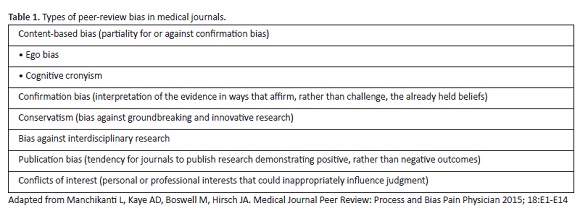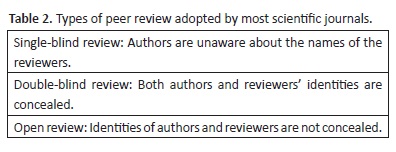Services on Demand
Journal
Article
Indicators
-
 Cited by SciELO
Cited by SciELO -
 Access statistics
Access statistics
Related links
-
 Similars in
SciELO
Similars in
SciELO
Share
Nascer e Crescer
Print version ISSN 0872-0754On-line version ISSN 2183-9417
Nascer e Crescer vol.28 no.1 Porto Mar. 2019
https://doi.org/10.25753/BirthGrowthMJ.v28.i1.17614
EDITORIAL
The importance of peer review
A importância da revisão por pares
Sílvia ÁlvaresI, II
I Editor-in-Chief of Nascer e Crescer - Birth and Growth Medical Journal; Department of Pediatric Cardiology, Centro Materno-Infantil do Norte, Centro Hospitalar Universitário do Porto. 4099-001 Porto, Portugal
II Clinical & Experimental Human Genomics, Unit for Multidisciplinary Research in Biomedicine, Instituto de Ciências Biomédicas Abel Salazar. 4050-313 Porto, Portugal silviaalvares.dia@chporto.min-saude.pt
Peer review can be defined as “a process of subjecting an author’s scholarly work, research or ideas to the scrutiny of others who are experts in the same field”.1 It is an essential component of the scientific process and medical publishing. Reviewers have two pivotal roles in the editorial process: to assess, with their expert judgement, if a submitted paper is suitable for publication and to provide constructive feedback to authors about how to improve the quality of the manuscript. Peer review represents a hard and demanding task: the reviewer must assess the manuscript, the validity of the research and methodology, the accuracy of the results, and the respect for ethics, and to (i) suggest alterations when appropriate, (ii) reject, or (iii) accept the manuscript without changes. It is also a lengthy process and time consuming job: the estimated time for reviewing a manuscript may take around eight hours (median - 2.7 hours)1-3.
Reviewers are volunteers and normally receive no payment. So what are the incentives for this time-consuming assignment? Motivations to peer review include spontaneous satisfaction from the activity itself, a sense of obligation to the community and their own area of research, personal contacts with the editorial board, and the opportunity to assess up-to-dated information about research advances. Financial incentives are still a matter of debate and controversy. Selecting reviewers is a crucial role for editors and also a difficult one. To ensure the review of a manuscript peer-review, invitations often have to be addressed to ten or more qualified potential reviewers.1-4
The peer review process has been subjected to criticism, such as delays in the publication cycle and peer review bias (Table 1).4-6 Despite its limitations and controversies, it is widely accepted and supported by the scientific community. Academics agree that peer review contributes to the quality of the submitted paper. Peer review is still considered essential in scientific and scholarly literature.7-9
Birth and Growth Medical Journal adopted the double-blind review mode (Table 2) assume the more effective way to ensure an impartial reviewer assessment and decision.
Peer review is not a perfect process and needs improvement. Referees are not infallible, work under time constraints, and sometimes are not the most suitable experts for the topic under review. But in general, the vast majority of peer-review processes does contribute to que quality of published articles. A good peer review should follow some basic principles: content integrity, content ethics, fairness, usefulness, and timeliness.10-11 The increasing focus on scientific research and publishing leads to a growing demand of reviewers who continue to have a fundamental role in the scientific community but are barely visible.12
The strategies and interventions to improve peer review and to reward referees are currently still a matter of debate and research. Some journals have implemented structured guidelines, courses for referees, statistical services and advice, and created incentives and rewards, but more effective measures to address this issue need to be pursued.13-14
The Birth and Growth Medical Journal expresses our gratitude and appreciation to all reviewers for sharing their time, knowledge, and expertise to ensure the high quality of the journal and their contribution to the scientific discourse.
REFERENCES
1. Kelly J, Sadeghieh T, Adeli K. Peer Review in Scientific Benefits, Critiques, & A Survival Guide EJIFCC. 2014; 25:227-43. [ Links ]
2. Zaharie MA, Seeber M. Are non-monetary rewards effective in attracting peer reviewers? A natural experiment. Scientometrics. 2018; 117:1587-609. https://doi.org/10.1007/s11192-018-2912-613. [ Links ]
3. Cho YG, Park HA. Peer review process in medical journals. Korean J Fam Med. 2013; 34:372-6. [ Links ]
4. Manchikanti L, Kaye AD, Boswell M, Hirsch JA. Medical Journal Peer Review: Process and Bias Pain Physician. 2015; 18:E1-E14. [ Links ]
5. Smith R. Peer review: a flawed process at the heart of science and journals J R Soc Med. 2006; 99:178-82. [ Links ]
6. Jefferson T, Rudin M, Brodney Folse S, et al. Editorial peer review for improving the quality of reports of biomedical studies. Cochrane Database Syst Rev. 2007:2. [ Links ]
7. Ware M. Peer Review: Benefits, Perceptions and Alternatives. PRC Summary Papers. 2008; 4:4-20. [ Links ]
8. Rowley JR, Sbaffi L. Academics’ attitudes towards peer review in scholarly journals and the effect of role and discipline. Journal of Information Science. 2017; 44:644-57. https://doi.org/10.1177/0165551517740821.
9. Blum K, Jacobs W, Modestino EJ, DiNubile N, Baron D, McLaughlin T, et al. Insurance companies fighting the peer review empire without any validity: The case for addiction and pain modalities in the face of an American drug epidemic. SEJ Surgery and Pain. 2018; 1:1-11. [ Links ]
10. Gannon F. The essential role of peer review. EMBO Rep. 2001; 2:743. [ Links ]
11. Allen H, Cury A, Gaston T , Graf C, Wakley H, Willis M. What does better peer review look like? Underlying principles and recommendations for better practice. Learned Publishing.2019. https://doi.org/10.1002/leap.1222. [ Links ]
12. Jackson L, Peters MA, Benade L, Devine N, Arndt S, Forster D, et al. Is peer review in academic publishing still working? Open Review of Educational Research 2018; 5:95-112. https://doi.org/10.1080/23265507.2018.1479139. [ Links ]
13. Stahel P, Moore EE. Peer review for biomedical publications: we can improve the system. BMC Medicine. 2014; 12:179-82. https://doi.org/10.1186/s12916-014-0179-1. [ Links ]
14. Patel J. Why training and specialization is needed for peer review: a case study of peer review for randomized controlled trials. BMC Med. 2014; 12:128. https://doi.org/10.1186/s12916-014-0128-z. [ Links ]
















